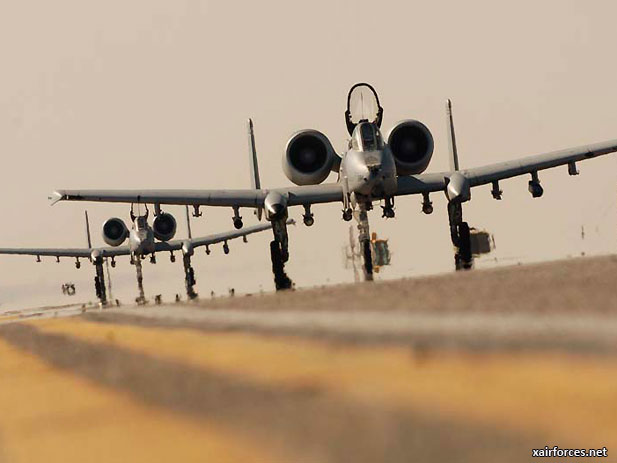
A-10s, F-16s targeted in latest budget talks

Key lawmakers debating the 2013 National Defense Authorization Bill are likely leaning toward freezing some aircraft cuts, while targeting some A-10s and F-16s for the chopping block, according to sources familiar with the process.
Meanwhile, the Air Force has offered a plan that would call for deeper cuts in active-duty personnel while restoring most of the planned cuts to Air National Guard personnel over the next five years, according to Air Force budget documents obtained by Air Force Times.
Top lawmakers in the conference committee on the authorization bill are looking to freeze cuts on the Air Force’s airlift assets, including C-5s, C-130s and C-27Js, while moving forward on cuts to the two types of fighters, according to a Capitol Hill staff member familiar with the plans.
While the lawmakers are looking at cutting the jets, they will leave it up to the Air Force to decide which jets and the time line for how they will be cut.
A more recent force structure proposal presented to Capitol Hill earlier this month identified three bases that would lose their jets.
The Air Force planned to retire 21 F-16s from the Iowa National Guard’s 132nd Fighter Wing at Des Moines; 20 A-10s of Arkansas National Guard’s 188th Fighter Wing at Fort Smith, Ark.; 24 A-10Cs of the Reserve 917th Fighter Group at Barksdale Air Force Base, La., according to a copy of the proposal obtained by Air Force Times.
The proposal also identified multiple retirements of airlifters, but congressional leaders are looking to preserve the Air Force’s airlift capacity until the Air Force can provide an analysis of the cutbacks, according to congressional staff.
Not surprisingly, U.S. Rep. Tom Latham, R., Iowa, issued a news release on Monday night blasting the proposed retirement of the F-16s in his home state.
“The negotiators have defied the will of House and Senate members who voted for the need to review the full national security implications and proper cost-benefit analysis of this agreement,” he said in the news release. “I oppose this plan that in essence complies with the White House’s proposal to retire the F-16s of the 132nd Fighter Wing, and I will vote against this legislation when it is considered by the House.”
The Air Force’s proposed fiscal 2013 budget was eviscerated in Congress because the service called for cutting 9,900 airmen this fiscal year, most of whom would come from the Air National Guard, but lawmakers sought to preserve jobs and aircraft in their states.
The proposed cuts were part of a broader move to cut a total 11,600 airmen over the next five years, of which 4,200 would be active-duty, 5,500 would come from the Air National Guard and 1,900 would be from the reserve, according to the Air Force budget documents.
On Nov. 28, the Air Force submitted a compromise to lawmakers that would reduce the force by 9,500 airmen over five years: 6,200 active-duty airmen, and 1,400 from the Guard and 1,900 reservists, the budget documents show.
The conference committee is expected to include the Senate’s proposed National Commission on the Structure of the Air Force, an independent group that would study appropriate Air Force force structure.
The bill is tentatively scheduled for a floor vote by the end of the week.
On Dec. 11, Defense Secretary Leon Panetta warned that he would recommend that President Obama veto the authorization bill if it blocked Air Force’s plans to reduce the number of airmen and aircraft, because the department would have to “operate, sustain, and maintain aircraft that are in excess of national requirements and are not affordable in an austere budget environment.”
Last week, retired Maj. Gen. Gus. L. Hargett Jr, president of the National Guard Association of the United States, said his group was concerned that some on Capitol Hill were willing to pass part of the Air Force’s proposal, based on a false perception that state leaders and many in Congress supported the service’s proposal.
“I do know that there has been some misinformation on the Hill that some governors and some adjutants general have endorsed [an Air Force] alternative plan,” Hargett said in a statement. “This is the kind of mischief that can occur during conference, when a handful from the House and Senate can go behind closed doors and literally change legislation in the name of forging compromise between the two chambers.”
Source: By Brian Everstine and Jeff Schogol - Staff writers/ Air Force Times News - 17 December 2012
Photo: Two A-10C Thunderbolt II aircraft on Kandahar Airfield, Afghanistan in 2010 (Photo by Staff Sgt. Dayton Mitchell / Air Force)
(17.12.2012)
|